This set of Biophysics Multiple Choice Questions & Answers (MCQs) focuses on “Ion Exchange Chromatography”.
1. In the case of anion exchange chromatography, what will be the charge of the column wall?
a) Negative
b) Neutral
c) Positive
d) Doesn’t matter
View Answer
Explanation: Anion exchange chromatography means anions will be exchanged with the column. Anions are negatively charged. So, the column wall has to be Positive.
2. Which of the following material is used in the anion exchange column?
a) Bio-Rex 70
b) Diethyl-aminoethyl groups (DEAE)
c) DEAE-Sephadex
d) SP-Sepharose
View Answer
Explanation: Diethyl-aminoethyl groups (DEAE) is used in the anion exchange column. The component materials of the following column are -CH2CH2N(C2H5)2 which is a weak base. As the material is positive in nature so it is used as an ion exchange column.
3. Imagine 4 proteins A, B, C, D which has been eluted by ion exchange chromatography as described in the following picture. The X axis is showing the fraction number. If, with the increase in unit time, concentration of NaCl is increased by 1M then what will be the correct increasing order of charge of protein?
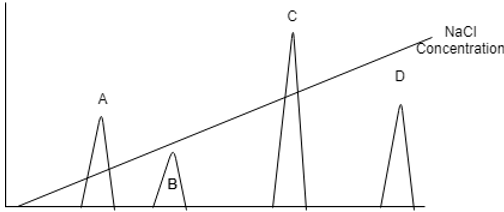
a) Protein A < Protein B < Protein C < Protein D
b) Protein B < Protein A < Protein C < Protein D
c) Protein A < Protein C < Protein B < Protein D
d) Protein A < Protein C < Protein D < Protein B
View Answer
Explanation: More the NaCl concentration is required that means the protein was more powerfully attached to the column. So, more the concentration of NaCl is required to elute the protein means the protein is highly charged so it was more powerfully attached to the column. Therefore, the correct order of the charge of the protein is Protein A < Protein B < Protein C < Protein D.
4. Imagine the following picture is a common ion exchange chromatography where a mixture of 4 proteins are eluted. Their axis of this graph shows standard Ion Exchange Chromatography nomenclature. Which protein present in the highest concentration in the mixture?
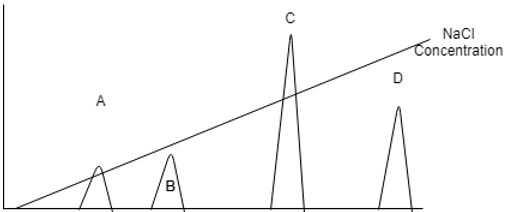
a) Protein A
b) Protein B
c) Protein C
d) Protein D
View Answer
Explanation: Protein C is present in the highest concentration in the mixture. The peak of the protein C is maximum, it means that protein C was present in the maximum amount irrespective of the position of the peak in X-axis.
5. Imagine the following image is a cation exchange chromatography where X-axis is fraction number. Now, if NaCl concentration is increased 1M per unit time then arrange the proteins according to their decreasing charge.
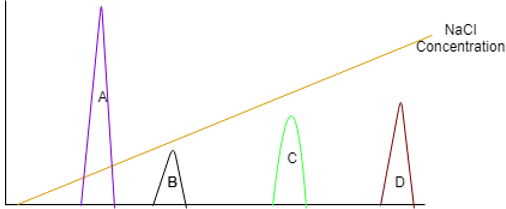
a) A > C > B > D
b) D > C > B > A
c) B > C > D > A
d) D > C > A > B
View Answer
Explanation: For elution, if NaCl requirement is very high for elution of a particular protein which means the charge of the protein is very high compared to other proteins. Based on this concept, the decreasing order of the charge of the protein is D > C >B > A.
6. If the following image is an anion exchange chromatography then which protein is the most negative and which one is the least negative?
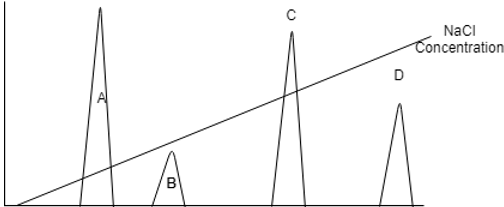
a) D is the most negative and B is the least negative
b) A is the most negative and D is the least negative
c) C is the most negative and A is the least negative
d) D is the most negative and A is the least negative
View Answer
Explanation: In the case of anion exchange chromatography, the highest NaCl concentration is required for higher negative protein because in anion exchange chromatography the exchanger protein is negative or anion. Therefore, D is the most negative and A is the least negative as for protein D highest NaCl was required and for protein A lowest NaCl was required.
7. Imagine the following image is a demonstration of Ion exchange chromatography. Where NaCl concentration is increased 2M per unit time. What will be the most positive protein if this is a cation exchange chromatography and what will be the most positive protein if this is an anion exchange chromatography?
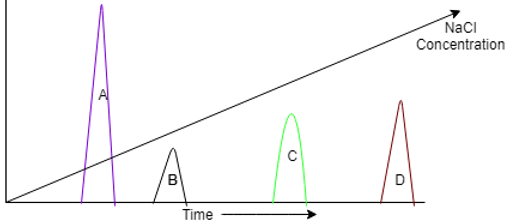
a) D if cation exchange chromatography and A if anion exchange chromatography
b) A if cation exchange chromatography and D if anion exchange chromatography
c) B if cation exchange chromatography and A if anion exchange chromatography
d) C if cation exchange chromatography and A if anion exchange chromatography
View Answer
Explanation: In cation exchange chromatography, higher concentration of NaCl is required for the elution of highly charged cation similarly in case of anion exchange chromatography higher concentration of NaCl is required for the elution of highly charged anion. Therefore, highly positive protein will be protein D if cation exchange chromatography and the answer will be protein A if anion exchange chromatography.
8. You have 4 protein P, Q, X, Y with overall charge 2+, 4+, 1-, 8+ respectively. For elution through cation exchange chromatography, which protein do require the highest NaCl concentration?
a) P
b) Q
c) X
d) Y
View Answer
Explanation: For a cation exchange chromatography, higher NaCl concentration is required for the elution of higher positively charged protein molecule. This is because, the interaction between positively charged proteins with negatively charged column wall is very high therefore, higher NaCl concentration is required to break the interaction and elute the protein.
9. CM-cellulose is used in the column of anion exchange chromatography.
a) True
b) False
View Answer
Explanation: CM-cellulose is a weakly charged molecule. The charge of CM-cellulose is negative which can be used in cation exchange chromatography. For anion exchange chromatography, the column has to be positive in charge.
10. What is the charge of proteins in anion exchange chromatography?
a) Negative
b) Positive
c) Neutral
d) Zwitterion
View Answer
Explanation: In case of anion exchange chromatography, the exchanger molecule or the protein molecule is negative in charge. The wall of the column in anion exchange chromatography is thereby positive in nature.
11. Ion exchange chromatography does not depend on which of the following property?
a) pH
b) Salt concentration
c) Buffer
d) Molecular weight of the protein
View Answer
Explanation: Ion exchange chromatography depends on those properties which affect the charge of the protein molecule. As pH, Salt concentration and buffer composition can affect the charge of the molecule therefore the answer is Molecular weight of the protein.
12. After elution through ion exchange chromatography, which of the technique you will use to determine the concentration protein present in the collected fraction?
a) Fluorescence at 365
b) Absorbance at 295 nm
c) Absorbance at 365 nm
d) Fluorescence at 265
View Answer
Explanation: Irrespective of the technique, for the determination of protein concentration in a mixture the biochemical method or spectroscopic method is used. As protein contains tryptophan so measuring the absorbance at 295nm will be useful for protein concentration determination.
13. Which of the following material is used as an anion exchanger?
a) DEAE cellulose
b) CM-cellulose
c) Sepharose
d) Bio-Rex 70
View Answer
Explanation: Diethylaminoethyl (DEAE) – cellulose is used as anion exchange chromatography as an anion exchanger. DEAE is a positive molecule therefore it attracts negative molecule so used as an anion exchanger.
14. Which of the following is the functional group of DEAE cellulose?
a) -COOH
b) -CH2CH2N(C2H5)2
c) -CH2OH
d) -CH2SO3H
View Answer
Explanation: -CH2CH2N(C2H5)2 is the functional group for DEAE cellulose. Whereas, -CH2SO3H is a functional group for SP sepharose.
15. Basic column in ion exchange chromatography is used as a _________
a) cation exchanger
b) anion exchanger
c) neutral exchanger
d) both cation and anion exchanger
View Answer
Explanation: Basic column means its constituents are positive. Now, positive will bind with negative protein or anion therefore, basic column is used as an anion exchanger.
Sanfoundry Global Education & Learning Series – Biophysics.
To practice all areas of Biophysics, here is complete set of 1000+ Multiple Choice Questions and Answers.
If you find a mistake in question / option / answer, kindly take a screenshot and email to [email protected]
